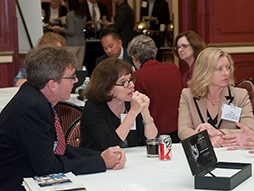As the health care system and patient care needs continue to evolve, the amount of knowledge available to physicians increases exponentially. Medical educators are rethinking how to prepare students to be the best physicians of the future, reevaluating traditional classroom models and experimenting with new curriculum based on how students learn and assess themselves.
“We need to focus not only on what we teach our students but on really understanding what they learn and what they’ll take forward into residency and into practice,” said Karen Hauer, MD, associate professor of clinical medicine at University of California San Francisco (UCSF)and a member of the school’s team that is implementing bold curriculum changes as part of a grant from the AMA’s Accelerating Change in Medical Education initiative.
Each of the 11 schools that received a $1 million grant from the AMA as part of this initiative has woven a competency-based assessment component into its innovative medical education curriculum. One of the advantages of a competency-based assessment framework is that a student who shows competence earlier in one area may be able to move ahead more quickly, or may be able to dedicate time to another area where that student needs more instruction. This model also encourages self-assessment and identifying one’s own strengths and weaknesses.
“This allows us to move away from a one-size-fits-all education,” Dr. Hauer said.
At UCSF, students will have individualized educational trajectories built against standardized outcomes. Called the “Bridges Curriculum,” this model allows students to accelerate through their medical education while ensuring all graduates can effectively execute the comprehensive set of responsibilities required of a physician working in today’s collaborative medical environment.
UCSF and Vanderbilt University are among the initiative schools with major competency-based assessment components. Vanderbilt’s Curriculum 2.0 is based on the assumption that an inflexible, classroom- and clerkship-based curriculum should be replaced by one that focuses on lifelong learning. With this model, students will be able to assess what they don’t know and understand how to find and synthesize that information.
“The students seem to be really engaged in this approach,” said Kim Lomis, MD, associate dean for undergraduate medical education at Vanderbilt. “We’re helping them to identify their strengths and weaknesses, and then how to optimize strengths and build upon weaknesses. As a class, they seem to work more collaboratively … they are embracing milestones and the self-assessment system, and they’re setting learning goals that are meaningful.”
Competency-based approaches to learning at the grant schools include evidence-based self-assessments and personalized learning plans. But a move to curriculum based on competency—not solely on time and tests—will be challenging, presenting issues around faculty development, data management and administrative flexibility.
Dr. Hauer says the ultimate goal of competency-based learning is to “assess our learners doing the things that are most important for patient care. In the past, we’ve used a lot of proxy measures, which is not really how well a student can take care of a patient. I’m hopeful we can use information from our assessments to help students make informed, evidence-based decisions about their learning goals.”
A learning consortium comprised of the 11 grant schools and the AMA is determining what milestones should be used to measure competency and is currently creating milestones that the grant schools will start to use and track.
“We wonder if just laying out the milestones for students to see can allow them to be able to leap over a couple steps since they will know their targets instead of stumbling in the dark,” said Dr. Lomis. “We’re opening up that black box and letting them see what we’re looking for.”




